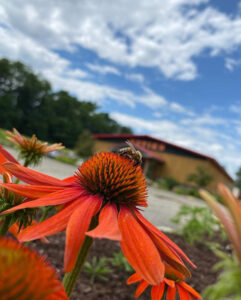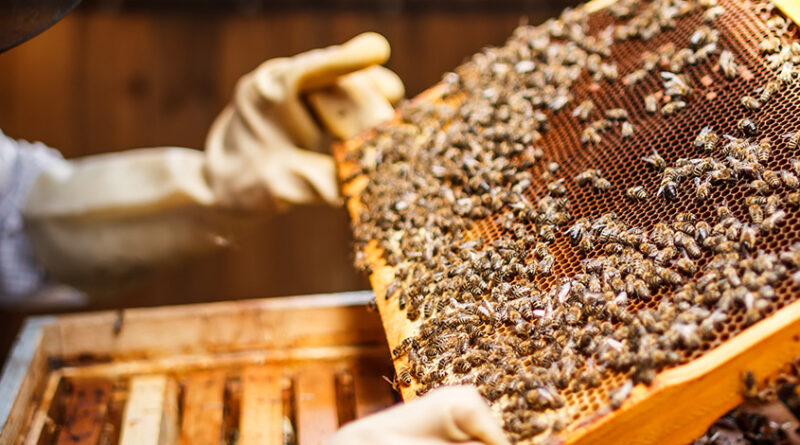The Buzz About Chuck Kutik
By Deborah Jeanne Sergeant

Chuck Kutik of Oxford, Chenango County, has been keeping bees since the 1970s when he received two beehives as a Christmas gift.
From that hobby eventually grew a business, Kutik’s Everything Bees.
Now 70, Kutik recalls feeling fascinated with bees as a child. Once he started keeping bees, he expanded his knowledge through shadowing mentors, one of whom was the state bee inspector.
Kutik trekked out to the woods with him to check out some commercial bee yards. As the bees hummed and flew through the sun-filtered canopy, the glittering bees looked like tiny jewels. At that moment, Kutik knew he would become a commercial beekeeper.
Handling bees and working them inevitably means stings, despite wearing gloves and a bonnet. There’s always a crack or gap where a stinger can get through. However, Kutik said that the stings don’t bother him as much as they first did.
His business has three branches: Kutik’s Honey Farm, a honey packing business; Kutik’s Pollination Service, which offers pollination on farms and makes honey; and Kutik’s Nucs and Queens. A “nuc” is a small hive of five frames. The business also sells equipment that supplies companies to resell them to their customers and sells equipment directly to beekeepers.
The honey business has been tough recently with three poor years of low crops in a row, each totally 500,000 pounds instead of the normal 800,000 to 900,000 pounds.
Varroa mites have decimated many commercial hives. These pests chew holes through bees’ exoskeleton which makes bees susceptible to viruses. Kutik decreases mite populations by luring them away to drones. He sorts out drones by providing a “drone comb” which is a structure offering the larger sized openings that drones prefer. Since mites prefer attacking drones, Kutik can cull the affected drones and thereby reduce mite populations in a hive. He prefers this to spraying miticide.
Environmental threats also make beekeeping tough.
“Pesticides are always an issue,” Kutik said.
Farmers spraying plants also affect bees. Moving the hives before spraying episodes seems a simple answer. However, with 2,000 hives to move, it’s a lot of work.
Strategically spraying at night when hives are less active helps decrease the fallout.
Kutik has his hives trucked to California for almond pollination. They join two-thirds of the commercial honeybees in the U.S. in their annual “work trip” to California. The hives travel on flatbed trucks, 400 hives per load. Although covered with a net, “it’s like trying to keep water in a sieve; a few find a way out,” Kutik said.
The bees’ stay in California lasts from mid-February through the end of March typically.
Once back home, the bees’ foraging becomes tougher. The loss of wildflowers in yards and lack of hedgerows thick with flowering trees has been hard on anyone in the bee business. Bees forage for up to two miles and rely upon wild growth.
“A lot of people kill everything and spray everything,” Kutik said. “It’s one of the biggest issues is losing forage every year.”
 Shifts in agriculture also affect beekeeping. Corn is wind-pollinated. More farmers are planting corn to meet the demand for ethanol and grain for non pastured animals. Eliminating millions of acres of pastureland thick with clover, alfalfa and other bee-friendly plants and planting them in corn has made it tougher for bees to find forage.
Shifts in agriculture also affect beekeeping. Corn is wind-pollinated. More farmers are planting corn to meet the demand for ethanol and grain for non pastured animals. Eliminating millions of acres of pastureland thick with clover, alfalfa and other bee-friendly plants and planting them in corn has made it tougher for bees to find forage.
By the middle of November, Kutik has the bees trucked to South Carolina to enjoy warmer weather. The maple trees begin blooming in January. The bees become more active and Kutik can make up more nucs and raise more queens to sell.
Kutik’s retail store, Everything Bees, boasts waterfalls and six-sided, glass-enclosed observation hive, where visitors can walk inside and feel surrounded by bees. The store’s adjacent pollinator garden promotes plants that attract and support bees.
“We’re expanding on that every year,” Kutik said.
He hopes to eventually offer a tasting room for honey mead at the store.
His niece, Lindsey Moroch, is one of his business partners. He also has close to a dozen employees helping him and 19 seasonal migrant workers from January through mid-November.
Beekeeping sounds like a sweet way to make easy money. However, Kutik said that’s not so.
“If someone wants a hive, I ask why,” he said. “If they say I want my own honey, I say to buy from a local beekeeper; it will be a lot cheaper. If they want a hive as a hobby, get their hands in there, enjoy the bees and don’t worry about making honey.”
It costs about $175 to $200 for one frame nuc — the equipment — and $300 to $400 for a hive of bees to put in it. A 60-pound pail of honey is $200.
Despite the difficulties of beekeeping, Kutik said that he feels “blessed really well” to work with bees, along with his wife, Karen.
“You have to have a really understanding wife who doesn’t mind moving bees all night and sleeping in a truck sometimes,” he quipped. “We got to see a lot of sunsets and sunrises in the same day. It’s a great life.”

